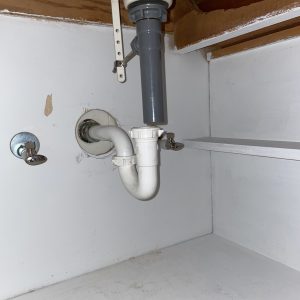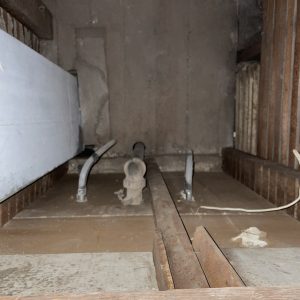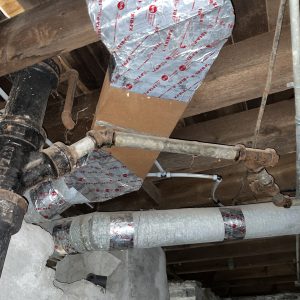Do I need an air admittance valve for my sink?
I have a house built in 1881 with plumbing that was put in sometime in the early 1900s. There is a half bath on the first floor with its own stack that takes care of our bathroom sink and toilet. The half bath has been in place for decades without any issue in terms of smells although I have only lived here for a year. The sink does drain pretty slowly though which made me wonder if the sink could use an air admittance valve under the sink 4” above the drain line.
The cast iron is the drain line directly drains the toilet with the sink drainage steel wye connecting to that at an angle (in third picture). For code reference I am located in Iowa. A concrete floor was poured sometime in 1980 that obscures how it is connected to the main drain.
I want to slowly update my DWV system in a code compliant way. My goal is to do this in a way that also minimizes roof penetrations, plaster removal, etc., assuming making the toilet/sink drainage code compliant is possible without major work.





















Replies
I’d be more inclined to think of replacing that steel drain line. Have you had that clean out open in the third picture?
I agree with Calvin.
You can also run a snake down that drain to check for obstructions.
new PVC drain lines would flow a lot better, and be more resistant to clogging up.
"without much of an issue in smells"?
Any sewer gas smell is an issue. The purpose of an air admittance valve is to protect the trap seal, the normal 2 inches of water column in the trap. By that, it does not let the draining water create enough suction to suck the trap dry. There comes the sewer gas into your living space. In actual practice it is hard to do, you pull the drain plug after shaving and suck the trap dry as the water goes down the drain, but you rinse the sink and the seal gets refilled. However a code official will NOT buy into that.
An air admittance valve will fail. That thin diaphram will fail. The valve does require regular maintenance.
Many states allow an upsizied drain line into a properly vented drainage system to be classified as a vented system.
Hard to see what you are dumping into, but... If I were to do it, I would replace the drainage branch line with 2 inch pvc, properly pitched, glued and supported. That is provided I could get a 2 inch line into your properly vented sanitary main. If that cast wye is 4x2 you are good. Oatey makes (made?) a glue substance called lead replacement, or something like that. Remove the galvinized, pack new oakum on and smear the Oatey product in.
Guess I should have studied the pics better, A 1 1/2 inch pvc drain is an upsize to a 1 1/4 in lavatory drain.
Everyone,
Thank you for your feedback. I updated the main post to provide a bit more information. The clean out is rusted shut so I haven’t been able to snake it which I’m assuming is the real source of my issues.
The consensus seems to be to upsize the drain and I can see you’re all right. Long term I think this is the best solution as you’ve all pointed out. Should I upsize the lavatory sink drain 2 sizes to 2” given that the branch drain serving both the toilet and sink don’t have a vent? The toilet (cast iron) drain in picture 3 is a 4” drain. Would code require that I do anything special to remedy the lack of a vent there?
An approved aav couldn't hurt. But you'd probably be better off with new drain piping. Over time unvented steel drain piping will build up scale, rust, mineral deposits, organic matter, etc..
Sanitary sewers rarely yield the same pungent odors as a septic tank, and it's possible there is a 4" house trap somewhere in your main drain.......
Depending upon where you live, you could get a drain professional to run a camera down through your system to give you an idea what problems, if any, you have.
I worked in a building that had cast iron, about 130 years old. Over time the cast iron can just rot out. The client renting downstairs complained about a wet wall. I was the financial guy, but getting trades in was like pulling hen's teeth. I am attaching a picture of what I had to pull out and replace.
Of course, you need, there are several benefits:
Saving water, due to which it will be possible to pay smaller amounts for utilities;
Convenience and ease of operation of the water seal - for its operation it is necessary to use a special lever, button, or press on the plug itself;
The more aesthetic appearance of the sanitary bowl;
Ease of maintenance and care of the installation;